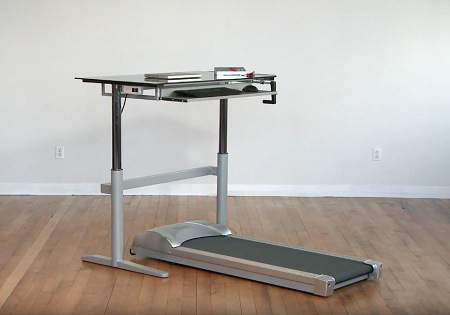Problems Associated With
Problems Associated With A Sedentary Lifestyle: Overview
More and more studies are finding that extended periods of sitting significantly increase our risk of developing various medical conditions, some of them serious. This is true even for those who exercise regularly.
- check your overall health status
- have a doctor review your case (optional)
- learn what you should be doing right now
A sedentary lifestyle is defined as a way of living that involves very little or no physical activity. In other words, a person who lives this way spends most of their time either sitting or lying down.

With increased computer use, video game playing and TV watching comes increased sitting. While the currently-recommended 30 minutes of daily physical activity is good for staying healthy, what you do during the remaining 23½ hours each day matters very much also.
In the same way that exercise will not reduce the risks that come from smoking, going to the gym after sitting for 8 hours at work is no better than going home and watching TV in terms of reducing risks.
Causes and Development
A variety of factors have led to large segments of the population – not just the elderly – becoming sedentary, including:
- The invention of machines to replace human labor
- The change from outdoor work to indoor/office work
- Television, computers, computer games, phones
- Social media, online shopping
- Busy lives, internet addiction
- The loss of safe and attractive outdoor environments
Most of us have become far more sedentary than our peers in centuries past. Even back in 1999, the CDC reported that "Nearly half of American youths aged 12-21 years are not vigorously active on a regular basis", and "About 14 percent of young people report no recent physical activity." This was before the advent of smartphones and social media: the situation now is far worse. And it is killing us.
Treatment and Prevention

There is good news. Studies are finding that even small increases in physical activity appear to have great positive benefits: Get up from your chair often and walk around. Get some fresh air, answer a phone call while walking, talk to someone in person rather than on the phone or by text message, or walk while having a meeting rather than sitting at a conference table.
The American Institute for Cancer Research recommends setting up your computer to remind you to get up and walk around every 60 minutes.
A study published October, 2011 in the journal Cancer Prevention Research found that for post-menopausal women, taking frequent breaks from sitting is associated with smaller waist circumference and lower levels of C-reactive proteins, both biomarkers associated with elevated risk of some cancers.
Activity does not need to be strenuous in order to be beneficial.
The National Health and Nutrition Examination Survey analyzed data of 4,757 participants and found that even short periods of light activity – for example frequently standing up and walking for as little as a minute – reduced biomarkers such as large waist circumference, elevated triglyceride levels and increased insulin resistance, which are linked to heightened cardiovascular disease and may also boost risk of various cancers.
Complications
The phrase "sitting is the new smoking" has become popular over recent years, and for good reason. Potential adverse consequences of a sedentary lifestyle include:
- increased waist circumference
- increased insulin resistance and risk of diabetes
- increased risk of breast cancer, colon cancer, and prostate cancer
- increased LDL ('bad') cholesterol levels and risk of cardiovascular disease
- (in women) a loss of bone mass of over 1% per year
Over the course of 10-20 years of sitting for 6 hours a day, it has been estimated a person loses up to 7 quality-adjusted life years – in other words years without medical issues or death.
References and Further Information
Research was presented in November, 2011 at the American Institute for Cancer Research's (AICR) annual conference. The AICR presented data suggesting that about 100,000 new cases of breast cancer and colon cancer per year can be associated with physical inactivity.
On This Page
A Sedentary Lifestyle:Signs, symptoms & indicators of Problems Associated With A Sedentary Lifestyle:
Symptoms - Sleep
 Regular/frequent postprandial somnolence
Regular/frequent postprandial somnolence
Exercise can keep you alert during the day and reduce the risk of post-meal tiredness. Many studies agree that regular exercise helps increase overall energy and reduce fatigue.
Conditions that suggest Problems Associated With A Sedentary Lifestyle:
Metabolic
 Syndrome X / Metabolic Syndrome
Syndrome X / Metabolic Syndrome
Many components of metabolic syndrome are associated with a sedentary lifestyle, including increased adipose tissue, reduced HDL cholesterol, and a trend toward increased triglycerides, blood pressure, and glucose in the genetically susceptible. Compared with individuals who watched television or videos or used their computer for less than one hour daily, those that carried out these behaviors for greater than four hours daily have a twofold increased risk of metabolic syndrome. [Fauci, Anthony S. (2008). Harrison's principles of internal medicine. McGraw-Hill Medical]
Risk factors for Problems Associated With A Sedentary Lifestyle:
Lifestyle
Problems Associated With A Sedentary Lifestyle suggests the following may be present:
Habits
Problems Associated With A Sedentary Lifestyle can lead to:
Circulation
 Coronary Disease / Heart Attack
Coronary Disease / Heart Attack
According to Dr. Emmanuel Stamatakis of University College London's Department of Epidemiology and Public Health, the risk of heart disease and premature death from any cause increases significantly for those spending more than fours hours a day watching television, surfing the web, or playing computer games.
The study was published in the Journal of the American College of Cardiology in January of 2011 and involved 4,512 adults who were respondents of the 2003 Scottish Health Survey. It found a 48% increased risk of all-cause mortality and an approximately 125% increase in risk of cardiovascular events among those spending more than four hours a day in front of a screen, and also suggests that even two hours of screen time each day may place someone at greater risk for a cardiac event. The risk appears to be irrespective of factors such as smoking, hypertension, BMI, social class, and even exercise.
Tumors, Malignant
 Breast Cancer
Breast Cancer
Risk of developing breast and colon cancers is significantly increased in those who spend a lot of time sitting, according to research presented in November of 2011 at the American Institute for Cancer Research.
 Colon Cancer
Colon Cancer
Risk of developing breast and colon cancers is significantly increased in those who spend a lot of time sitting, according to research presented in November of 2011 at the American Institute for Cancer Research.
Click to see sample report
Your body is a highly complex, interconnected system. Instead of guessing at what might be wrong, let us help you discover what is really going on inside your body based on the many clues it is giving.
Our multiple symptom checker provides in-depth health analysis by The Analyst™ with full explanations, recommendations and (optionally) doctors available for case review and answering your specific questions.
KEY








